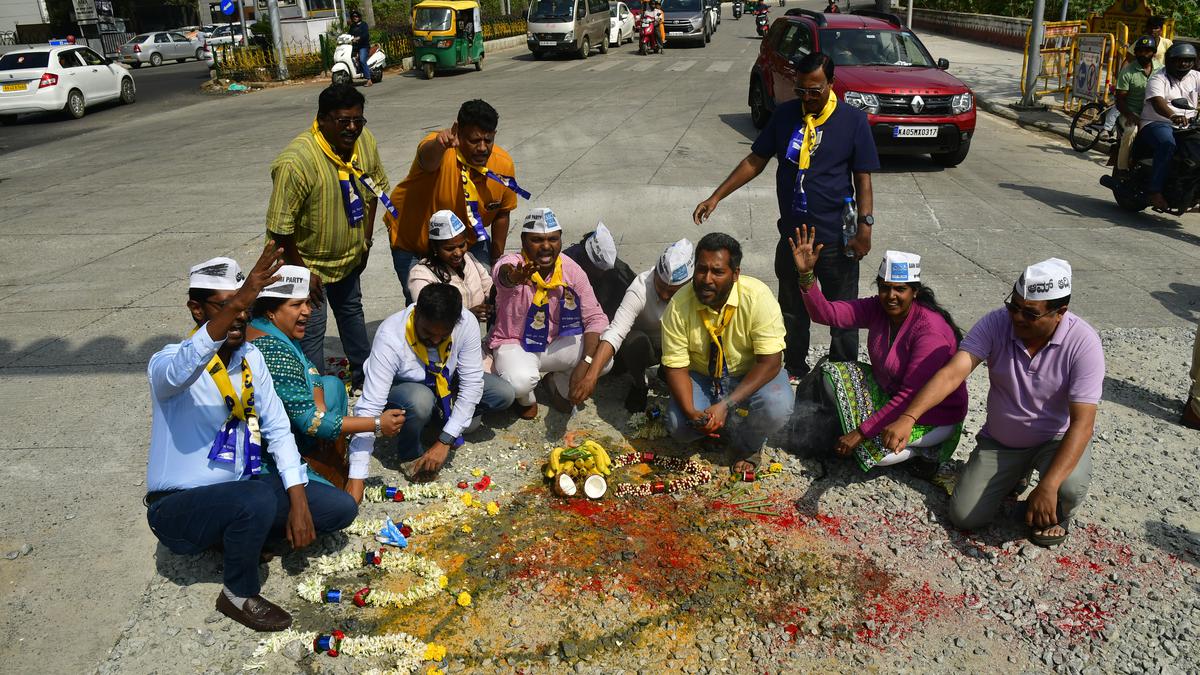
Days after sinkhole appears on Bengaluru road, DKS bats for more white-topping
The Hindu
Days after a newly white-topped part of the Kensington Road caved in, forming a giant sinkhole, Deputy Chief Minister (DCM) and Bengaluru Development Minister D.K. Shivakumar batted for white-topping of roads and termed it a solution to rid roads of potholes
Days after a newly white-topped part of the Kensington Road caved in, forming a giant sinkhole, Deputy Chief Minister (DCM) and Bengaluru Development Minister D.K. Shivakumar batted for white-topping of roads and termed it a solution to rid roads of potholes on Thursday.
He said white-topping of roads will solve this [potholes on roads] problem for 25 to 40 years.
The sinkhole on Kensington Road near the Ulsoor lake has drawn the ire of many, including the Aam Aadmi Party who held a protest on Wednesday and demanded a probe into the incident, as white-topping of roads, more costlier than asphalting, was pitched as a panacea for poor quality roads.
While the civic body has blamed water leakage for the sinkhole, the Bangalore Water Supply and Sewerage Board (BWSSB) has denied the same.
Responding to a query raised by H.S. Gopinath, MLC, during Question Hour, Mr. Shivakumar said that there had been demands to white-top even interior roads and he would soon call for a meeting of legislators from Bengaluru to discuss about white-topping of roads in the city.
“There are 1.14 crore vehicles in Bengaluru. Over 1,300 two-wheelers and 490 cars are registered daily. Heavy traffic movement is resulting in potholed roads, and white-topping will solve this problem as it lasts 25 to 40 years,” he said.
“There is an allocation of ₹1,000 crore for white-topping this year. However, there is a demand for white-topping smaller roads as well. I will soon call for a meeting of the legislators to understand the need for white-topping in different areas of Bengaluru,” he said.

Hampi, the UNESCO-recognised historical site, was the capital of the Vijayanagara empire from 1336 to 1565. Foreign travellers from Persia, Europe and other parts of the world have chronicled the wealth of the place and the unique cultural mores of this kingdom built on the banks of the Tungabhadra river. There are fine descriptions to be found of its temples, farms, markets and trading links, remnants of which one can see in the ruins now. The Literature, architecture of this era continue inspire awe.

Unfurling the zine handed to us at the start of the walk, we use brightly-coloured markers to draw squiggly cables across the page, starting from a sepia-toned vintage photograph of the telegraph office. Iz, who goes by the pronouns they/them, explains, “This building is still standing, though it shut down in 2013,” they say, pointing out that telegraphy, which started in Bengaluru in 1854, was an instrument of colonial power and control. “The British colonised lands via telegraph cables, something known as the All Red Line.”

The festival in Bengaluru is happening at various locations, including ATREE in Jakkur, Bangalore Creative Circus in Yeshwantpur, Courtyard Koota in Kengeri, and Medai the Stage in Koramangala. The festival will also take place in various cities across Karnataka including Tumakuru, Ramanagara, Mandya, Kolar, Chikkaballapura, Hassan, Chitradurga, Davangere, Chamarajanagar and Mysuru.








